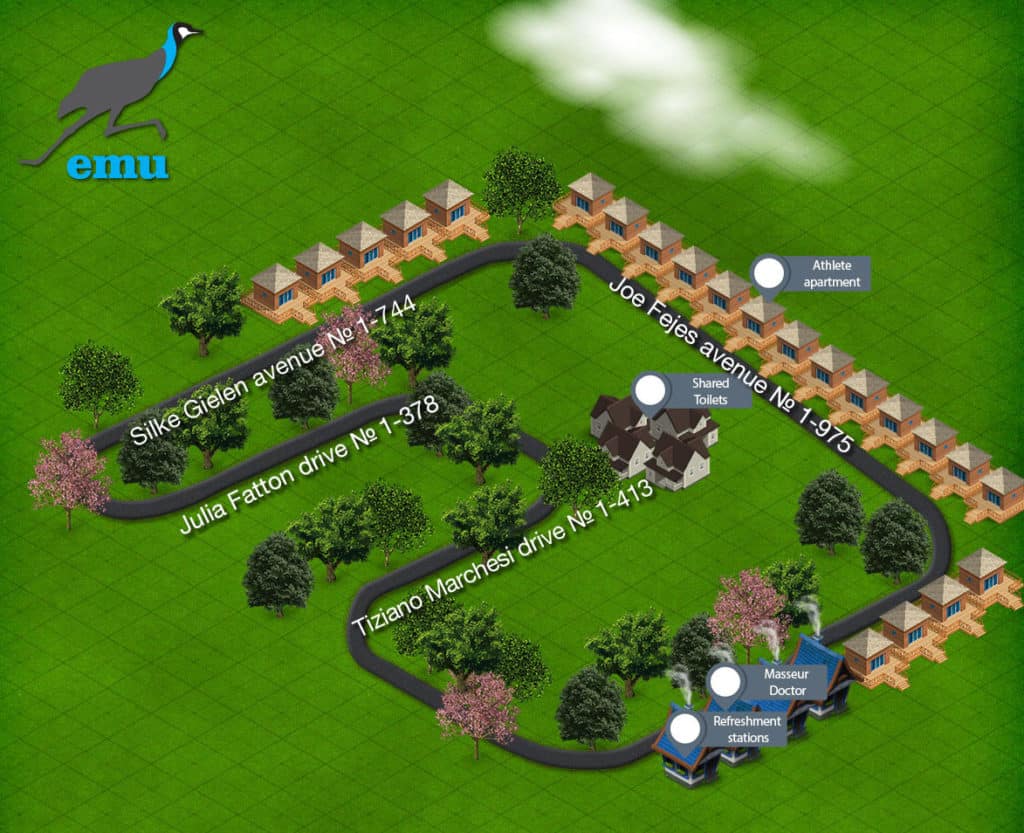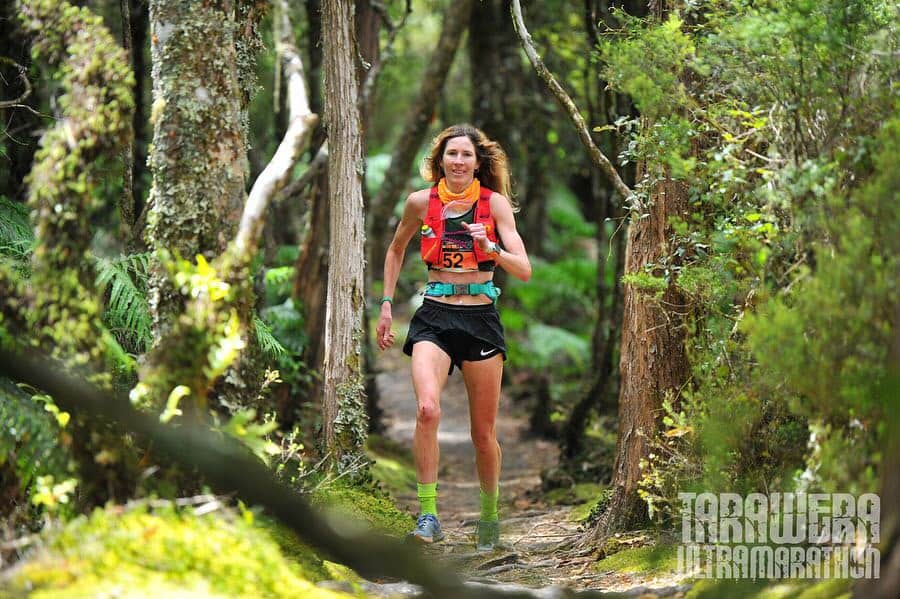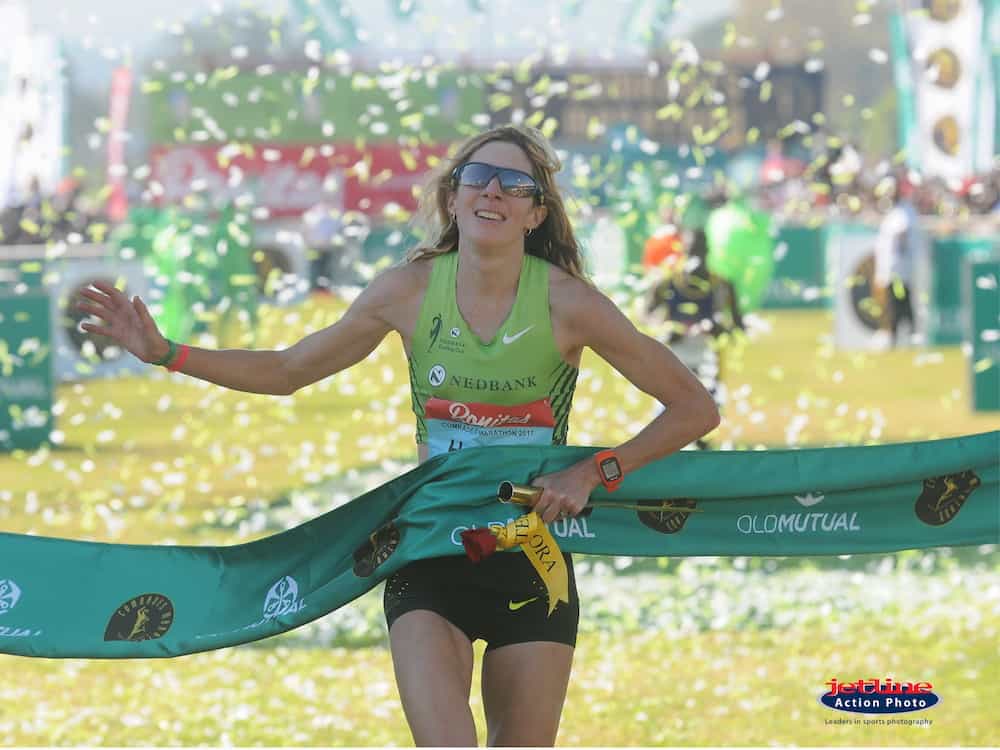Camille Herron Aims for Six-Day World Record at EMU (Hungary) | 600 Miles in Six Days!
By Chase Parnell — August 26, 2020 — 📸: Jetline Action Photos
**9/1/2020: Unfortunately, due to new Hungarian Covid-19 restrictions, Camille will not be able to participate in EMU. Stay tuned to see what she decides to do instead!**
On August 19, 2020, Camille Herron announced her plan to go after the unthinkable: 600 miles of running in six days. The math is easy on this one; she must average 100 miles per day for six days straight. That’s 4.17 miles per hour for 144 hours, which is a 14 minute 24 second per mile pace for 600 miles. But that’s if she ran continuously; those numbers do not take into account sleep or rest breaks, bathroom stops, time for changing gear, fueling, and any other unforeseen stops along the way.
If she accomplishes this 600 mile feat, she’ll obliterate the current women’s world record and shine a huge light on multiday racing events. The ultramarathon scene has shifted away from multidays with Western States, Hardrock, UTMB and other mountain running events rising in prominence over the last 2-3 decades. But maybe Camille’s six day run will be the spark that reignites the multiday flame. Maybe we’re ready to re-embrace the format that at one time was the pinnacle of this niche sport of ours.
On September 24, 2020 in Balatonfüred, Hungary, Camille will gather with an international elite field of multiday specialists. The longest timed event Camille has done is 24 hours; she’s skipping the other common distances of 48 and 72 hours and jumping straight to the six-day. Her rationale? “I’m not afraid to make the leap now. Yiannis Kouros’s 3rd ultra was a six-day race. With the way this year has gone, I feel I should just go for it!” Yiannis, if you haven’t followed this side of the sport, is the multiday greatest of all time (G.O.A.T.) on the men’s side. Camille is the women’s G.O.A.T. for the 24 hour run but hasn’t yet shown what she can do in the world of multidays. Can she make the leap and etch into stone a lasting mark? We’ll find out in T-minus 29 days.
Why Should We Care About Multiday Races?
Funny enough, both Camille and I share a common inspiration and it came in the form of a book: In Search of Al Howie by Jared Beasley. Had I not read that book, I probably wouldn’t have understood the significance of Camille’s announcement or been as interested in it generally. Camille said about the book, “It emotionally moved me and was definitely an impetus to making the leap to multidays.” So it would appear we have Al Howie, the chain-smoking Scotsman turned Canadian ultrarunning phenom, and the author who told his tale to thank, at least in part, for getting to see a world class runner in Camille take on a six-day race. We salute you.
Multiday races are stripped to the bone. Comparatively speaking, it’s all about the running; there aren’t major elevation changes, wildlife encounters, navigational challenges, or anything else to distract you from putting one foot in front of the other, ideally at a finely measured and metronomic pace. In a mountain ultra, you may lose the trail; in a multiday, you might lose your mind.
Many of the international multiday running races have 24 hour, 48 hour, 72 hour, six-day, and ten-day options. The classic distance, however, seems to be the six-day, which harkens back to the early days of the sport where competitors walked/ran for six days, Monday to Saturday, and then took a day of rest to complete a week in time. During the late 19th century in Britain, exhibitions were held, gambling bets were wagered, and men would walk extreme distances for sport. One event attracted over 10,000 spectators. They called it pedestrianism.
Today there are a few 1,000 mile races and many of you have likely heard of the 3,100 mile Sri Chinmoy Self-Transcendence run, which takes place on one large city block in New York City. Similar to the gradual build to a 100 mile trail race, there’s a nice progression of times and distances to chase if you dip your toes in the multiday waters and like what you find.
Why EMU Six-Day?

Bob Hearn, who is ranked 9th on the American six-day all-time list with 530 miles, said this about the course/event Camille chose, “It’s a flat loop, a little under a kilometer, with everything optimized for the runner. Everyone gets a cabin right on the course, with beds, kitchen, bathroom, etc. The timing is top-notch. The support is excellent, with constant ultra food and supplies at the aid station, real meals provided every six hours, and a 24-hour medical staff.”
If you find yourself with a spare couple of hours, sit back and read Bob’s 2018 EMU race report. It’s an incredibly well-written 11,000 word ultra read; the guy runs long and writes longer.
Bob found that if you want to make a run at a record, EMU is the place to do it. This fact was likely not lost on Camille.
Camille’s Racing Experience and Training

2019 IAU 24 Hour World Championships (📸: Rafa Romero)
Camille is the current world record holder for 50 miles (5:38:41), 100 miles (12:42:40), and 24 hours (167.84 miles). She is the reigning IAU World Champion for the 24 hour run, she won the extremely competitive Comrades Marathon in South Africa (55 miles) in 2017, and has found success on the trails as well, especially in New Zealand where she’s won both the 100 mile (2019) and 100k (2017) races of the Tarawera Ultramarathon. With that type of resume, this might be the most highly anticipated six-day debut of all time.
Interestingly, Camille’s training doesn’t change much no matter the event. She hasn’t been slogging out 12 hour days on her feet like you might expect for someone who intends on running for six days straight. Instead, she said, “I think it’s important to know your body, be smart with your training, and work at a level where you thrive and stay healthy. I’ve experimented a lot over the years, and sticking with my marathon training approach, with specificity to the surface/terrain, is what works for me for any distance.” She goes on to say, “I believe it’s the cumulative volume that you put in over time that gives you the strength to carry you for long distances. People are always surprised to hear my long runs are only 18-22 miles, and I’ve never done back-to-back long runs.”
While Camille might not follow the traditional ultrarunning training protocols, she recently divulged that she has averaged over 100 miles per week for the last 14 years and has over 90,000 lifetime miles. You want to run like Camille? There’s your formula.
As far as specificity before a race, she said, “I get in 900-1000 miles in the 8 weeks leading up to a race. I run twice a day most days (12-13 runs per week) and 100-130 miles per week.” She says, “I like to do a marathon/50K race 3-6 weeks out from a peak race, which gets the body ‘race ready’ and practice gear and nutrition/hydration. I focus on feeling good and springy going into any race!” UltraSignup shows Camille as currently registered for the Katy Trail 50k on September 5th, which is just 19 days before EMU.
Current Six-Day Record Holders
Camille is not shy about her intentions, “I’ve been closing the gap to the men’s World Records the further I run, so my curiosity is piqued if I can continue to close the gap or maybe even exceed a men’s multiday World Record!” Camille is the third fastest American of any gender in the 24 hour run, just five miles short of Mike Morton’s overall record, so this isn’t an empty claim by any means. If she’s that close in the 24 hour, and it does seem that women do lessen the gap as distances increase, there’s really no telling what she could do in the six-day. Here are the carrots that Camille will be chasing on race day:
- Women’s American Record: 514.8 miles (Dipali Cunningham)
- Women’s World Record: 548.3 miles (Sandy Barwick)
- Men’s American record: 606.2 miles (Joe Fejes)
- Men’s world record is: 658.7 miles (Yiannis Kouros)
I have to believe that if Camille somehow wills herself to the 600 mile range, you better believe that 606.2 mile overall American record will come into play. For the all-time rankings for most of the classic ultra distances, check out Ultrarunning Magazine’s lists.
A Brand New Challenge for Camille

Camille en route to victory on the trails. 📸: Tarawera Ultramarathon
After diving into this world of multidays, it seems to me you have to really nail four things in order to knock it out of the park: pacing, nutrition, sleep, and foot care. Pacing and nutrition are nothing new, but calculating splits and nutritional needs for this long of an effort (and for a variety of different mileage goals) requires more than mental math or a simple calculator. After reading a handful of multiday race reports, I’ve never seen so many spreadsheets! I’m sure you can run a good six-day off of heart and intuition, but that doesn’t seem to be the norm for those who excel. Pardon the pun.
Sleep is not a factor in “short” ultras and foot care definitely doesn’t make the top four in a]your typical list of concerns. So this is a new game! Camille will be dealing with massive sleep deprivation and unique mental and physiological challenges she’s never faced before; with these added variables, the calculus will be all new.
It took Walmsley three tries to win Western, it took Meltzer three attempts on the Appalachian Trail to get the FKT, but Camille isn’t mapping with them — she’s talking about Kouros — and he won his first six-day race and set a world record while doing it.
Maybe she can too.
Updates & Live Tracking
It’s worth noting that the EMU website is ancient and in Hungarian. Their facebook page is the much better resource. Take a second to LIKE it so you’ll receive their posts in your feed. They’re currently spotlighting a new participant each day and counting down to race day. Mark your calendars for September 24th, make sure to follow Camille and Treeline Journal on Twitter for updates, and start getting excited for what might be a truly legendary run.
Enjoy this article? Consider supporting us via Patreon for as little as $2 a month. We appreciate your support; it goes a long way in keeping Treeline Journal afloat!



I’m looking forward to seeing what Camille can do.
The Colac 6-day race in Australia played an important part in 6-day racing history with both Yiannis Kouros and British runner Eleanor Adams setting world best performances there in the inaugural 1984 race (Kouros 1023.2km Adams 806.4km). Adams won the women’s race five times setting more world bests culminating in 866.8km in 1989, finishing just ahead of Sandra Barwick. Barwick bettered that the following year with the current world best of 883.631km.
And it was in 2005 at the last Colac race that Kouros set the current world best.
http://runyoung50.co.uk/colac-6-day-race-1984/
Thanks for sharing! Colac would’ve been fun to witness. 400 meter track! I think I’d prefer EMU’s 1,000 meter course but both have fantastic histories. Do you know why Colac fell apart? Nobody was there to organize after 2005?
It may have been the longest-running 6-day event at the time that it stopped. Various efforts were made to keep the race going between 2006 and 2008 but it seems that not enough athletes wanted to compete and there may have been difficulties with the location. Somehow the race had lost its spark. Maybe it was partly following the death of Cliff Young, the Australian ultrarunning folk hero, in 2003. (Phil Essam is the real expert on this story as he was one of the people who tried to keep it going).
Thankyou Katie for the mention. I think Colac was one of a kind and it is hard to tell if we will see another one quite like it. Cliffy was responsible for bringing the 6 Day to Colac and in the end , i guess the race ran its course ! ( not a deliberate pun). The Volunteers were generally not from an Ultra background and like most community groups , they got tired. Australia does have another 6 day races slowly developing its own status. Its not on this year , but look for it to be back on the Ultra schedule in 2021 .
Aplogies in advance for the haphazard comment –
Kouros’ official 6 day record (637) is his softest and I’d expect it to be broken at some point should serious talented runners chase it. Colac I do not believe was certified and is not the official record, though, many of “us” treat it as such. Kouros estimated he was capable of 1200 km, and his best efforts over ~1000 km he saved for the famed Sydney to Melbourne race. The race route varied on the years. The year he abandoned the race to run it solo, he broke 5 days. I believe Mr Essam can elaborate on thatt.
On paper, Camille should be capable of over 600 and the American Record. She has superior leg speed to Fejes, and she is running it at an age far younger than Fejes did (around age 50).
According to two of the best multi-day handlers in the world, EMU 6 day is the de facto 6 day world championship, and is the single best multiday race venue around.
Between the mens’ American and World records, there is also 1000 km, an internationally more recognized benchmark than 600 miles, and of course, the all time rankings including those from the Professional Era (sometimes erroneously referred to as the Pedestrian Era, though by then, they were all running).
The best all time (modern era, not authoritative, but the closest we have) list is not UR Mag’s which only lists performances from discrete domestic individuals, but on DUV Statistik. See all-time modern-era men here:
http://statistik.d-u-v.org/getintbestlist.php?year=all&dist=6d&gender=M&cat=all&nat=all&label=&hili=none&tt=netto&Submit.x=25&Submit.y=6
there are other multiday options including Candice Burt’s various trail 200+ miles races, the Iditarod 350, Vol State, etc. And there are any number of opportunities for one to dip her toes into the multiday world.
>>While Camille might not follow the traditional ultrarunning training protocols . . .
Her training is actually a lot more conventional and traditional than the trendy protocols (as of the last 20 years) widely perceived as conventional wisdom (back to back LRs, etc).
>>Many of the international races have 24, 48, 72, six-day, and ten-day options . . .
The very first fixed time races (all races are timed) were walking contests (pedestrian) until they evolved to “go as you please” (including running) races. That early 20th century era of high flying athletes with huge prize purses is known as the Professional Era. Like many long endurance efforts, these began as bar bets. How far can you go in a day became how far can you go in a week – but Blue Laws of the day precluded racing on Sunday, hence 6 days as a standard distance. Those puritan laws at times even mandated a buffer pre and post that Sunday rest day, so 144 hour contests were not infrequently actually 142 hour contests. Though some countries maintain records for non-standard distances, the most prominent organizational bodies including the IAU and USATF only maintain records for distances (or fixed time intervals) raced at a high level with a certain degree of frequency. As such, 24hrs, 48hrs, and 6days all have international records and domestic. There are those of us who maintain lists for other distances, but 10 days, though long-held by the Sri Chinmoy Marathon Team, is a somewhat arbitrary distance, and the 1,000 mile has a bit more cachet to it (though still no records). 72 hours is an odd duck – countries like Canada, parts of the UK, etc maintain records, and I believe it should become a widely sanctioned distance seeing its recent popularity, and given some history of 500 km races, but as it stands, it’s not a ‘distance’ for which we have proper records. I believe the US record would be Joe Fejes’ 336 mile 72 hr split in his 606 mile performance.
>>It’s worth noting that the EMU website is ancient and in Hungarian
Before bashing – It’s worth noting that the EMU website is functional with google chrome translate, and they share prior year race splits for all days in Excel format. Their tracking is next to none.
There is to date, no material evidence to the curious notion that the gap that exists between biological sexes at shorter distances, disappears over longer distances. Certainly the longer the distance, more factors come into play, and race management (calories, sleep, injury) matters.
Thanks Steel Town Runner, I knew I was swimming a little out of my lane in writing about multiday events; my only goal was to shine a light on Camille and hopefully add some excitement for what’s to come at EMU. I’m excited to learn more about multidays as we follow along with Camille. Thank you for your contributions and added nuance. I think readers will benefit from the added layer.
Just a nitpick: Kouros’s actual IAU 6-day WR is 1036.8 km, or 644.2 miles (from Colac 2005), not 658.7 or 637. Camille may say 600 but I am sure she is thinking of Kouros!
https://iau-ultramarathon.org/assets/pdf/rankings/IAU%20Records%20Committee%202017_2020_RecordsTable_20200126.pdf
Unfortunately, just an hour ago, the EMU Facebook page said that the race is cancelled this year. Due to Hungary not allowing ant foreigners in after 1 Sept. Rescheduled for 6 May.
It’s on my calendar! I cant wait to see what Camille will dol
Thanks for notifying. I updated the post. Sad to hear this!